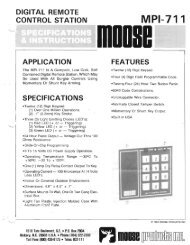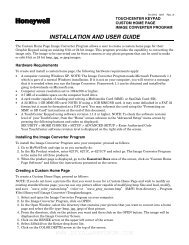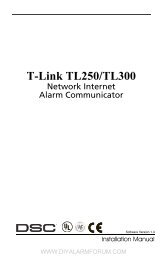sentrol - DIY Alarm Forum
sentrol - DIY Alarm Forum
sentrol - DIY Alarm Forum
You also want an ePaper? Increase the reach of your titles
YUMPU automatically turns print PDFs into web optimized ePapers that Google loves.
.........................................................................................................................................................................<br />
Commercial & Industrial Applications<br />
EXTREME CONDITIONS<br />
APPLICATION<br />
INSTALLATION<br />
RECOMMENDED<br />
PRODUCTS<br />
Meat lockers, unregulated buildings in very hot or cold climates, and other areas of<br />
extreme temperature often require space protection.<br />
Refer to Protecting Vacation Homes and Garages in the Residential Applications<br />
for installation instructions.<br />
For industrial applications in very cold<br />
environments, Sentrol manufactures the<br />
6187CTX PIR. It operates down to<br />
-40°C (-40°F). The 6155CT can also<br />
be used in cold climates, but is housed in<br />
standard plastic.<br />
For very hot environments where the<br />
temperature differential between a<br />
person and the surrounding air is very<br />
small, Sentrol offers the Sharpshooter<br />
6155XT, which can distinguish<br />
temperature differences as small as 1°C.<br />
Sunlight—Avoid direct sunlight on the<br />
plastic lens (even with UV stable plastics).<br />
SPACE DETECTION<br />
Temperature—The 6187CTX PIR is rated to perform from -40°F (40°C) to<br />
+120°F (+50°C). Be aware of a temperature in excess of these specifications.<br />
Humidity/Rain/Fog—Make sure the conduit openings are well sealed and the<br />
mounting holes are sealed.<br />
Birds & Animals—Depending on the size, speed and proximity to the detector,<br />
warm blooded animals can trigger an alarm. The larger the animal, the further away<br />
it can be detected. Mount the PIR high-at least 7 ft. (2.13m)-on a flat surface that<br />
discourages rodents or birds from perching. Avoid directing the sensor towards<br />
bushes or branches where birds could perch. You may consider mounting two PIRs,<br />
one above the other, in parallel to require verification of alarm.<br />
Weeds & Bushes—Tree branches or bushes can cause an alarm when the wind<br />
moves them, and weeds and bushes can block detection. Keep branches and bushes<br />
at least 30 feet (9.15m) from the PIR.<br />
Install the PIR away from vines or vegetation that could block the view.<br />
Testing your installation over a 24-hour period can help troubleshoot any false alarm<br />
sources. Take the time to know your environment. Up front planning is always less<br />
expensive than unwanted alarms later.<br />
WWW.<strong>DIY</strong>ALARMFORUM.COM<br />
2.26





